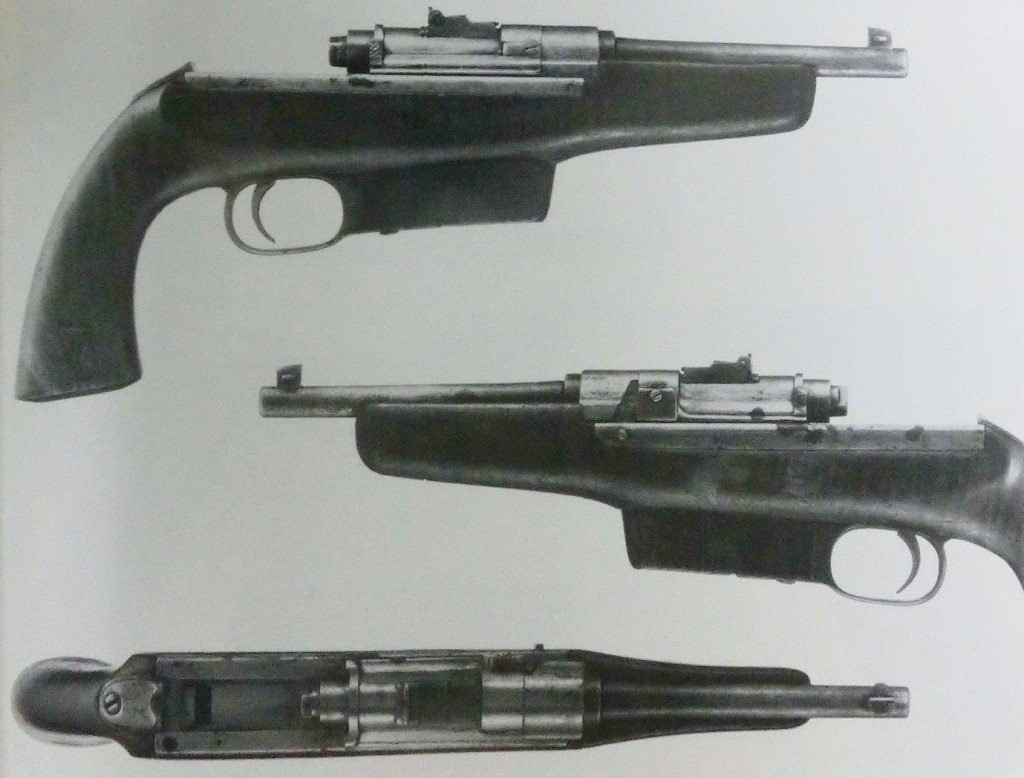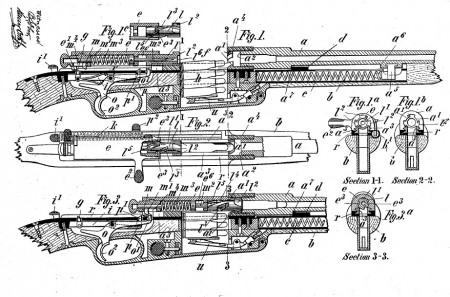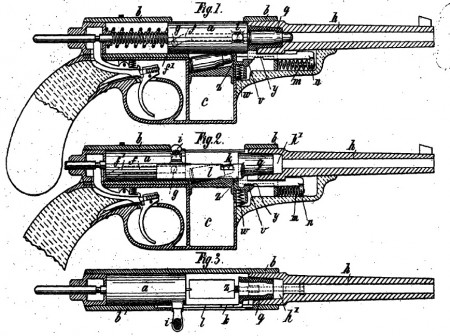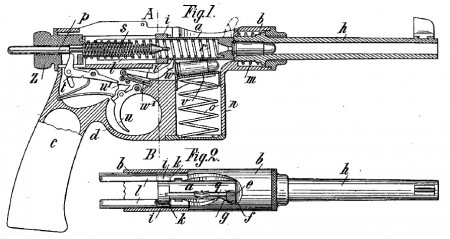German inventor Claus Claudius patented a design for a long-recoil automatic pistol in 1895, and we ran across a couple photos of an example of it that was actually manufactured:

We found the photo in Faustfeuerwaffen II, by Christian Reinhart and Michael am Rhyn – a pretty cool compendium of pistols tested by the Swiss Army. At any rate, it looked interesting, and I wanted to find out more about it.
Some patent searching led to two sets of patents filed internationally, one in 1895 (which covers this actual manufactured example) and a second set in 1900. Let’s start with the physical sample gun – it is an 1895 pattern, and operates using a long recoil system and a rotating bolt. The bolt locking lugs are cut in a helical shape with matching grooves in the breech. Being a long recoil system, the bolt and barrel remain locked together for the full length of travel (which you can see in the exposed rails behind the bolt in the photos above). The spiral shaped locking lugs are intended to force the system to remain locked during recoil travel, as the rearward motion acting of the lugs behaves like a screw being tightened. Once the rear limit of travel is reached, the bolt locks in place and a return spring under the barrel forces the barrel forward, and now the lugs act like a screw being loosened. The bolt rotates to unlock, freeing the barrel and allowing it to be pushed forward to its resting position.
In most long-recoil systems, the bolt is automatically released to chamber a new cartridge when the barrel reaches its forwardmost position. The patent description of Clausius’ pistol, however, suggests that the bolt would remain open until a lever on the side of the action is manually depressed by the shooter to release the bolt. The photographs of the prototype pistol above, however, show no sign of such a lever. The patent also describes an unusual set of controls by which the energy in the compressed firing pin spring can be used to push the bolt open, allowing the gun to be unloaded without firing. That system also appears to be absent from the prototype pistol. That shouldn’t be too surprising, as such a system adds needless complexity to the design, which can be manually opened by simply pulling the bolt back by hand.

The prototype pistol photographed above is likely the only existing example of Clausius’ pistol, as it was not adopted by any military force (it may not have even been formally tested anywhere), nor did it go into commercial production. However, Clausius continued to tinker, as evidenced by a subsequent set of patents he filed in 1900.
His subsequent idea was to maintain use of a recoil-operated system, but have only a portion of the barrel actually move. The majority of the barrel would be fixed, which would reduce the chances of dirt or fouling jamming up its movement. What he wanted to do instead was have basically the chamber area of the barrel made as a separate plug, which would recoil inside the main body of the barrel upon firing.

This would actually make the gun a short-recoil type, since the drawing shows the chamber plug moving only a short distance, and inertia providing the motivation for the bolt to continue traveling backwards after the chamber stopped. As it happens, this is very similar to the floating chamber system patented by David “Carbine” Williams in the US several decades later for use in .22LR conversions.
To my knowledge, no examples of the 1900 version exist, and they may never have been built in the first place. If they were build, there is still some serious question as to the practicality of the system in a moderate or large cartridge, as high pressure gas is likely to leak between the barrel and chamber plug, fouling the system and potentially blowing back into the shooter’s face. Perhaps the system could have been perfected using a cartridge case longer than the chamber plug (thus sealing the gap between the barrel and chamber) and balancing the bolt and spring weights to prevent the action from opening until pressure had dropped significantly? I don’t know…but it doesn’t look likely, because Clausius dropped the idea himself.
A final set of patents was registered in 1905, which appear to abandon the floating chamber idea in favor of a fairly typical short-recoil system. The barrel (the whole barrel) recoils just a short distance, and the inertia from that movement drives the bolt fully rearward:

Patents
1895 Version:
Swiss Patent #11481
British Patent #25042
US Patent #593835
1900 Version:
British Patent #13649
1905 Version:
Swiss Patent #32998
French Patent #351597

1 Trackback / Pingback